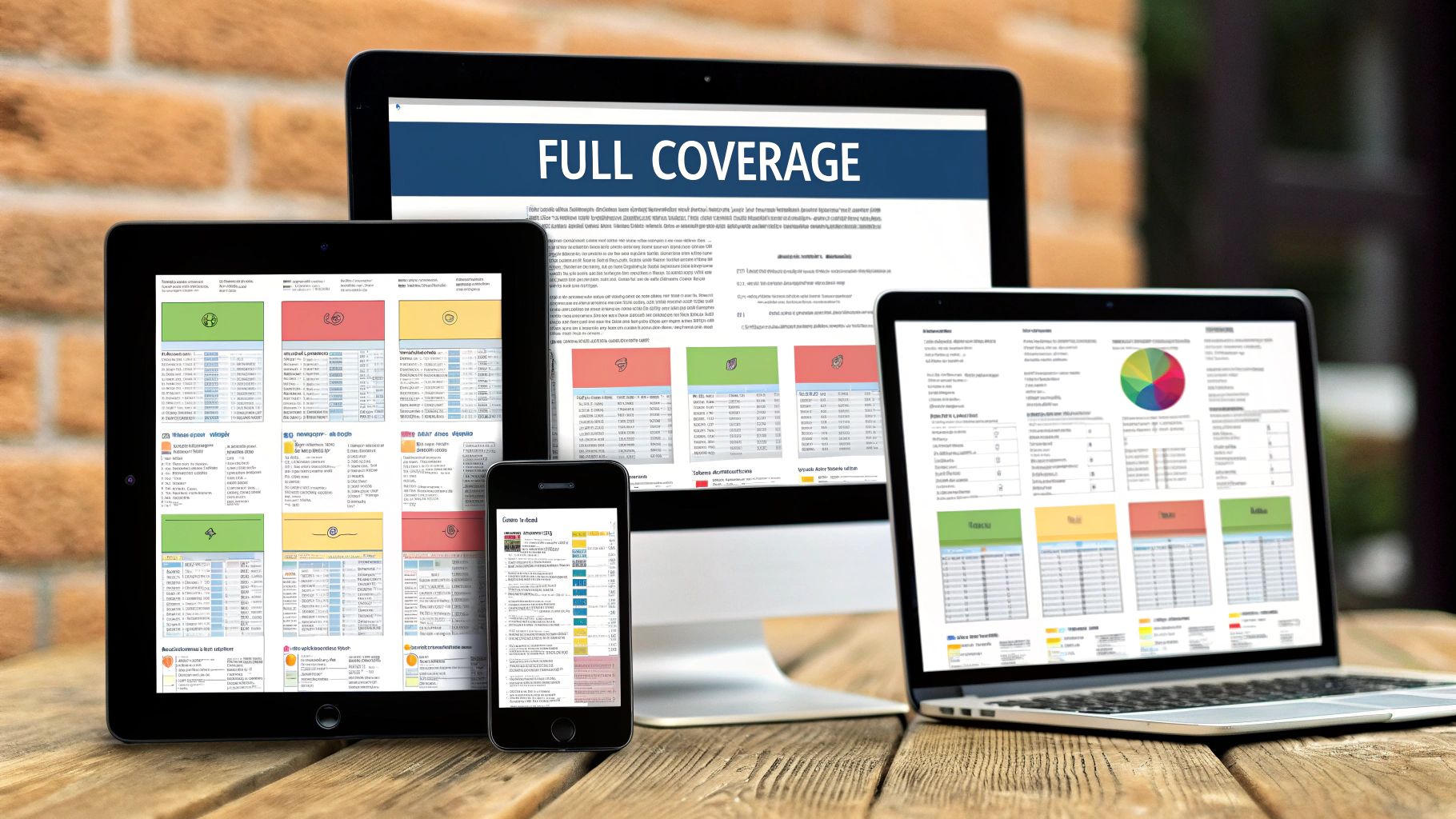Top Test Automation Benefits to Boost Your Development in 2025
In today's fast-paced software development landscape, speed and quality are non-negotiable. While manual testing has its place, it often creates bottlenecks, slows down releases, and struggles to keep up with agile demands. This is where test automation steps in, not just as a replacement, but as a strategic amplifier for your entire development process. The core test automation benefits extend far beyond simply finding bugs faster; they transform how teams build, test, and deploy software.
This article moves beyond the obvious to provide actionable insights for your team. We will break down eight specific advantages that show how automation delivers tangible value. From providing rapid feedback that accelerates innovation to ensuring consistent quality that builds user trust, automation is the backbone of modern, high-performing engineering teams. Let's explore the most impactful benefits that demonstrate why adopting a robust automation strategy is critical for success in 2025 and beyond.
1. Faster Test Execution and Feedback Cycles
One of the most immediate and impactful test automation benefits is the dramatic increase in testing speed. Automated scripts can execute thousands of complex test cases in the time it takes a manual tester to complete just a few. This acceleration is not just about finishing tests faster; it’s about shortening the entire development feedback loop, which is crucial in Agile and DevOps environments.

When tests run continuously with every code commit, developers receive nearly instant feedback on their changes. This allows them to identify and resolve bugs while the context is still fresh in their minds, preventing defects from escalating into more complex, costly problems later in the development cycle.
Implementation in Practice
Tech giants leverage this speed to maintain quality at an incredible scale. For instance, Google runs millions of automated tests daily across its vast portfolio of products, while Facebook integrates automated testing directly into its CI/CD pipeline, triggering tests on every single code commit. This ensures that new code doesn't break existing functionality, enabling a rapid and reliable release cadence.
Actionable Tips for Faster Feedback
To fully realize this benefit, consider these strategies:
- Implement Parallelization: Run multiple tests simultaneously across different environments or devices to drastically reduce overall execution time.
- Utilize Cloud-Based Platforms: Leverage platforms like Sauce Labs or BrowserStack to scale your testing infrastructure on-demand without managing physical hardware.
- Prioritize Critical Paths: Focus initial automation efforts on the most critical user journeys to get the fastest possible feedback on core application health.
2. Improved Test Coverage and Consistency
One of the most significant test automation benefits is the ability to achieve broader and more consistent test coverage. Unlike manual testing, which can be prone to human error and variation, automated scripts execute the same tests precisely every time. This systematic approach ensures that no critical functionality is accidentally skipped and that tests are performed identically across different browsers, devices, and configurations.

Automated testing enables teams to run a vast matrix of test cases that would be logistically impossible to cover manually, such as testing thousands of data permutations or complex user workflows. This thoroughness helps uncover edge-case bugs and ensures the application is robust under diverse conditions, leading to a higher-quality product. For those interested in this approach, you can explore the principles of data-driven testing in depth at Dotmock's blog.
Implementation in Practice
Leading technology companies rely on this benefit to ensure product quality across a wide user base. For instance, Microsoft uses automated testing to validate that Office 365 works seamlessly across more than 40 different browsers. Similarly, Spotify maintains an impressive 95% code coverage through its extensive suite of automated tests, ensuring stability with every new feature release.
Actionable Tips for Better Coverage
To maximize your test coverage and consistency, implement these strategies:
- Implement Risk-Based Testing: Focus automation efforts on the most critical and high-risk areas of the application first to maximize impact.
- Combine Test Types: Use a mix of unit, integration, and end-to-end tests to create a comprehensive testing pyramid that covers the application at every level.
- Review and Refactor Regularly: Keep your test suites aligned with application changes by regularly reviewing, updating, and refactoring your scripts to prevent them from becoming obsolete.
3. Significant Cost Reduction Over Time
While test automation requires an initial investment in tools, infrastructure, and skilled personnel, it delivers substantial cost savings in the long run. This is one of the most compelling test automation benefits for businesses. Automated tests run indefinitely without incurring additional labor costs, drastically reducing the cumulative expense of repetitive manual testing, especially for regression suites that must be executed for every new release.

Furthermore, automation catches bugs early in the development cycle when they are significantly cheaper and faster to fix. A defect found in production can cost up to 100 times more to resolve than one identified during the development phase. By shifting defect detection left, automation directly minimizes expensive post-release hotfixes and protects revenue.
Implementation in Practice
The financial impact of test automation is well-documented across various industries. For instance, a case study on IBM revealed an 80% cost reduction in their testing efforts after implementing a robust automation strategy. Similarly, Deutsche Bank successfully reduced its testing costs by 70% by automating its processes, demonstrating that even complex financial systems can achieve massive savings.
Actionable Tips for Maximizing ROI
To ensure automation translates into tangible cost savings, focus on these strategies:
- Calculate ROI: Regularly calculate the return on investment by comparing the cost of automation (tools, training) against the hours of manual testing saved.
- Start with High-Value Cases: Prioritize automating stable, high-traffic, and business-critical test cases to secure quick wins and demonstrate value to stakeholders.
- Invest in a Scalable Framework: Build or adopt a reusable and maintainable test automation framework to reduce the long-term cost of script creation and upkeep.
4. Enhanced Software Quality and Reliability
A core benefit of test automation is the significant boost in overall software quality and reliability. By running comprehensive test suites frequently, teams can catch bugs much earlier in the development cycle. This consistent and repeatable validation ensures that both new features and existing functionality work as expected, leading to more stable and trustworthy software releases with fewer production defects.

Automated tests act as a safety net, meticulously checking for regressions and unintended side effects with every code change. This rigor allows development teams to build and iterate with confidence, knowing that a baseline of quality is continuously enforced. The result is a more robust application and a better end-user experience, directly impacting customer satisfaction and brand reputation.
Implementation in Practice
Leading companies rely on automation to uphold their quality standards. For instance, Etsy reduced its production bugs by an estimated 60% after implementing a comprehensive automated testing culture. Similarly, PayPal leverages extensive automation to help maintain its impressive 99.9% uptime reliability, ensuring its critical financial services are always available and functioning correctly for millions of users worldwide.
Actionable Tips for Higher Quality
To leverage automation for improved reliability, integrate these practices:
- Implement Shift-Left Testing: Introduce testing early in the development lifecycle to find and fix defects when they are cheapest to resolve.
- Cover Functional and Non-Functional Tests: Use automation for both feature validation and performance, security, and load testing to ensure all aspects of quality are covered. Learn more about automated functional testing on dotmock.com.
- Combine with Exploratory Testing: While automation handles repeatable checks, use manual exploratory testing to uncover unique, edge-case bugs that scripts might miss.
5. 24/7 Testing Capability and Scalability
One of the most powerful test automation benefits is the ability to run tests continuously without human intervention, enabling true round-the-clock validation. Automated test suites can execute overnight, on weekends, and across different time zones, ensuring that product quality is monitored constantly. This untethers your testing efforts from the standard workday, maximizing productivity and providing a continuous stream of feedback.
This constant testing capability allows organizations to scale their quality assurance efforts without proportionally increasing manual testing headcount. As an application grows in complexity, the automated test suite can expand with it, handling a larger volume and variety of tests efficiently.
Implementation in Practice
Leading technology companies rely on this 24/7 capability to maintain system integrity at a global scale. For instance, Amazon Web Services (AWS) runs automated tests continuously across its global data centers to ensure service reliability, while GitHub executes automated tests on thousands of repositories simultaneously with every push, providing constant validation for developers worldwide.
Actionable Tips for Scalable Testing
To achieve continuous, scalable testing, consider these strategies:
- Implement Robust Monitoring: Set up automated alerts for test failures to ensure that critical issues are flagged immediately, even when no one is actively watching the test runs.
- Use Containerization: Employ tools like Docker to create consistent, isolated test environments, eliminating the "it works on my machine" problem and ensuring reliable results.
- Design for Independence: Build tests that can run independently and in any order. This is a prerequisite for effective parallelization, a key technique for scaling test execution. You can learn more about parallel testing on dotmock.com.
6. Better Resource allocation and Team Productivity
One of the most strategic test automation benefits is the ability to reallocate your most valuable asset: your team's time. By automating repetitive, time-consuming regression tests, you free up skilled QA engineers to focus on high-impact activities that require human intellect, creativity, and intuition, such as exploratory and usability testing. This shift doesn't just eliminate drudgery; it elevates the role of QA from defect detection to quality assurance.
This strategic resource allocation leads to a more engaged, productive team and a higher-quality product. When testers can apply their expertise to complex problem-solving and improving the user experience, their job satisfaction and overall team morale increase significantly.
Implementation in Practice
Leading companies use automation to empower their teams and drive efficiency. For example, Spotify was able to reallocate 60% of its QA team's time to high-value exploratory testing after implementing a robust automation strategy. Similarly, LinkedIn reduced QA bottlenecks by an impressive 80%, enabling a more fluid and efficient development lifecycle.
Actionable Tips for Better Allocation
To effectively reallocate your team's resources and boost productivity, focus on these steps:
- Provide Upskilling Opportunities: Invest in training for your manual testers in automation scripting, test strategy, and other advanced QA disciplines.
- Define Clear Roles: Establish distinct responsibilities for developers (unit tests), automation engineers (scripting), and manual QA (exploratory testing) to create a collaborative ecosystem.
- Measure and Communicate Gains: Track metrics like the percentage of time shifted to exploratory testing and share these productivity improvements to demonstrate the value of automation.
7. Comprehensive Documentation and Reporting
Beyond just finding bugs, a key test automation benefit is the creation of detailed, consistent documentation and reporting. Automated testing frameworks generate comprehensive logs, test results, and performance data, which serve as a living record of the application's behavior and quality over time. This creates a valuable knowledge base and an auditable trail for every test run.
This automatic record-keeping is invaluable for debugging, as developers can pinpoint the exact moment a failure occurred with detailed logs and screenshots. Furthermore, this data supports compliance requirements, provides stakeholders with clear visibility into project health, and fuels continuous improvement by highlighting recurring problem areas.
Implementation in Practice
This benefit is crucial in highly regulated and complex industries. For example, financial institutions like JPMorgan Chase leverage automated test reports to provide evidence of due diligence for regulatory compliance audits. Similarly, Tesla relies on comprehensive test documentation from its automated suites to track vehicle software quality and ensure safety standards are met with every update.
Actionable Tips for Better Reporting
To maximize the value of your test documentation, focus on these strategies:
- Implement Dashboard Tools: Use tools like Grafana, Kibana, or integrated reporting features in platforms like TestRail to visualize test results and trends for easy stakeholder consumption.
- Define Key Metrics (KPIs): Track and report on essential metrics such as pass/fail rates, test duration, and defect density to measure quality improvements over time.
- Automate Report Distribution: Configure your CI/CD pipeline to automatically generate and distribute summary reports to relevant teams via email or Slack after each test run.
8. Support for Agile and DevOps Practices
Test automation is the engine that powers modern Agile and DevOps methodologies. It is a foundational practice that enables the core principles of continuous integration, continuous delivery (CI/CD), and rapid iteration. By automating the validation process, teams gain the confidence to integrate and deploy code frequently without sacrificing quality.
This synergy between automation and agile practices creates a high-velocity development cycle where feedback is constant and releases are small, frequent, and reliable. Without it, the "continuous" aspect of CI/CD becomes a bottleneck, as manual testing cannot keep pace with the speed of automated builds and deployments. This is one of the most critical test automation benefits for modern software teams.
Implementation in Practice
The world's most innovative companies rely on this principle to maintain their competitive edge. For instance, Netflix deploys code changes thousands of times per day, a feat only possible through a sophisticated, fully automated testing and delivery pipeline. Similarly, Google's culture of continuous deployment is built upon a comprehensive suite of automated tests that validate changes across its massive codebase, ensuring stability with every release.
Actionable Tips for Agile Integration
To seamlessly integrate automation into your Agile and DevOps workflows, consider these strategies:
- Integrate Tests into the Pipeline: Start by embedding automated tests for critical user workflows directly into your CI/CD pipeline, making them a mandatory step for every build.
- Make Automation "Definition of Done": Include the creation of corresponding automated tests as a requirement for any new feature or user story to be considered complete.
- Use Feature Flags with Automated Monitoring: Deploy new features behind flags and use automated tests and monitoring to validate their performance in production before a full rollout.
8 Key Benefits Comparison
| Feature / Item | Implementation Complexity 🔄 | Resource Requirements ⚡ | Expected Outcomes 📊 | Ideal Use Cases 💡 | Key Advantages ⭐ |
|---|---|---|---|---|---|
| Faster Test Execution and Feedback Cycles | Medium - requires setup and stable environments | High - automated infrastructure & CI/CD | Rapid feedback, accelerated release cycles, frequent testing | Continuous Integration/Deployment, rapid iteration | Fast execution, immediate feedback, supports CD |
| Improved Test Coverage and Consistency | Medium to High - needs maintenance & updates | Medium - test maintenance and environments | Consistent, broad coverage across environments and browsers | Cross-platform/browser validation, regression | Eliminates human error, consistent test execution |
| Significant Cost Reduction Over Time | High initial - tooling & training required | Medium to High - initial investment | Long-term cost savings, lower manual effort, ROI in 6-12 months | Long-term projects with frequent regression tests | Substantial cost savings, scalable testing |
| Enhanced Software Quality and Reliability | Medium - requires well-designed tests | Medium - test design and execution | Fewer production defects, higher software reliability | Quality-critical releases, complex business logic | Early bug detection, consistent quality validation |
| 24/7 Testing Capability and Scalability | High - robust infra & monitoring needed | High - cloud resources and scaling | Continuous testing without human intervention | Global teams, massive test suites, multi-timezone | Maximizes infrastructure usage, supports scaling |
| Better Resource Allocation and Team Productivity | Medium - team training and process changes | Medium - training & collaboration tools | Frees testers for strategic work, faster product iterations | Teams shifting from manual to automated testing | Improves morale, reduces bottlenecks, enhances focus |
| Comprehensive Documentation and Reporting | Low to Medium - integration and customization | Low to Medium - reporting tools | Clear visibility, compliance support, data-driven decisions | Regulated industries, knowledge sharing | Detailed logs, audit trails, supports continuous improvement |
| Support for Agile and DevOps Practices | High - requires cultural shift & tool integration | Medium to High - infrastructure & tooling | Faster time-to-market, reduced deployment risks, continuous delivery | Agile/DevOps environments, rapid release cycles | Enables CI/CD, reduces risks, supports agile workflow |
From Theory to Practice: Taking the Next Step in Automation
Embracing the full spectrum of test automation benefits is a strategic transformation, not just a technical upgrade. It's about fundamentally shifting your development culture from manual, repetitive checks to an automated, intelligent validation framework. As we've explored, the advantages are profound and interconnected. Faster feedback cycles directly support Agile and DevOps methodologies, while improved test coverage enhances software quality and reliability.
This transition allows your team to reallocate valuable human intellect away from mundane tasks towards complex problem-solving and innovation. The result is not only significant long-term cost reduction but also a more engaged and productive engineering team. The consistent, comprehensive reporting generated by automated suites provides clear, actionable insights, turning testing from a quality gate into a continuous quality driver. Ultimately, these benefits compound to create a powerful competitive advantage, enabling you to deliver superior products to market faster and with greater confidence.
Overcoming the Implementation Hurdle
One of the most common hurdles in realizing these gains is establishing a stable and reliable test environment, especially when dealing with complex API dependencies or third-party services. Waiting for backend development to finish or dealing with unreliable external APIs can bring testing, and thus development, to a grinding halt. This is precisely where a strategic approach to mocking becomes invaluable.
By decoupling your frontend and backend testing workflows, you empower parallel development and eliminate critical bottlenecks. Simulating various API responses, including edge cases and failure scenarios like network timeouts or error codes, becomes simple and repeatable. This ensures your application is resilient and your user experience is robust under all conditions. Integrating a powerful mocking solution is a key accelerator, allowing your team to start reaping the test automation benefits immediately without environmental dependencies.
Ready to eliminate API bottlenecks and supercharge your testing strategy? Discover how dotMock can help you create production-ready mock APIs in seconds, enabling your team to build and test more resilient applications, faster. Explore the features and start your journey at dotMock.